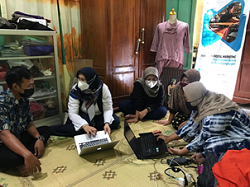Penerapan Digital Marketing dan Teknologi Alat Pemintal Benang Tenun Otomatis Ramah Lingkungan pada Pengrajin Lurik Mulyo Cawas Klaten Jawa Tengah Application of Digital Marketing and Technology for Environmentally Friendly Automatic Weaving Yarn Spinners at Lurik Craftsmen Mulyo Cawas Klaten, Central Java
Main Article Content
Abstract
Dusun Tegalmulyo Cawas Klaten, Central Java, is one of the centers for producing striated weaving using Non-Machine Weaving Equipment (ATBM). ATBM, owned by craftsmen, is a legacy from their predecessors and has been running for decades, including Kreasi's partner and Lurik Weaving Craftsman "Lurik Mulyo." Producing the woven fabric requires five stages and is carried out manually: dyeing and evaporation of yarn, spinning, arranging motifs, weaving, and finishing. Partners currently do not have direct customers; sales presently being made are sales through middlemen. So that if there are no middlemen who order, then the two partners will not get income, especially in conditions of the Covid-19 pandemic like this. The two partners also have no bargaining value because the middleman determines the selling price. Therefore, the expansion of the marketing area with the direct selling method through a digital marketing platform is one of the solutions offered in this program. The next problem is the inefficient and effective production process because it is done manually and can encourage high production costs. Therefore, the service team offers a solution by applying environmentally friendly automatic spinner technology by combining energy sources from solar cells and household electricity sources. The non-academic outcomes that will be achieved through this program are an increase in spinning process capacity to double, which is then patented, an increase in turnover by 50%, and an increase in direct customers by 50%.
Downloads
Article Details
Authors who publish with this journal agree to the following terms:
- Any article on the copyright is retained by the author(s).
- Author grant the journal, right of first publication with the work simultaneously licensed under a Creative Commons Attribution License that allows others to share work with acknowledgment of the work authors and initial publications in this journal.
- Authors are able to enter into a separate, additional contractual arrangements for non-exclusive distribution of published articles of work (eg, post-institutional repository) or publish it in a book, with acknowledgment of its initial publication in this journal.
- Authors are permitted and encouraged to post their work online (e.g., in institutional repositories or on their websites) prior to and during the submission process, as can lead to productive exchanges, as well as earlier and greater citation of published work.
- The article and any associated published material is distributed under the Creative Commons Attribution-ShareAlike 4.0 International License
References
Hadiwardoyo, W. 2020. Kerugian Ekonomi Nasional Akibat Pandemi Covid-19. Baskara: Journal of Business and Entrepreneurship. 2(2):83-92. https://doi.org/10.54268/baskara.2.2.83-92
Hanoatubun, S. 2020. Dampak Covid-19 terhadap Perekonomian Indonesia. EduPhyCouns: Journal of Education, Physchology and Counseling. 2(1):146-153
Harto, B., Komalasari, R. 2020. Optimalisasi Platform Online Internet Marketing Untuk SME Little Rose Bandung. Empowerment in the Community Journal. 1(1):1-6. http://dx.doi.org/10.31543/ecj.v1i1.357
Ihza, K.N. 2020. Dampak Covid-19 Terhadap Usaha Mikro Kecil dan Menengah (UMKM) (Studi Kasus UMKM Ikhwa Comp Desa Watesprojo, Kemalgi, Mojokerto). Jurnal Inovasi Penelitian. 1(7):1325-1331. https://doi.org/10.47492/jip.v1i7.268
Jansen, B.J., Resnick, M. 2006. An Examination of Searcher’s Perceptions of Nonsponsored and Sponsored Links During E-Commerce Web Searching. Journal of The American Society for Information Science and Technology. 57(14):1949-1961. https://doi.org/10.1002/asi.20425
Jauhari, J. 2010. Upaya pengembangan usaha kecil dan menengah (UKM) dengan memanfaatkan e-commerce. Jurnal Sistem Informasi. 2(1):1-12. https://doi.org/10.36706/jsi.v2i1.718
Priyambodo, L., Tjiptono, F., Suyoto. 2012. M-Commerce in Indonesia: Problems and Prospects. International Journal of Computer Applications and Information Technology. 1(2):71-76
Rahayu, R., Day, J. 2017. E-commerce adoption by SMEs in developing countries: evidence from Indonesia. Eurasian Business Review. 7:25–41. https://doi.org/10.1007/s40821-016-0044-6
Setiadi, A.F. 2020. Pemkab Klaten Kembangkan Kawasan Industri Lurik, Ini Strateginya. https://www.solopos.com/pemkab-klaten-kembangkan-kawasan-industri-lurik-ini-strateginya-1096171
Turban, E, King, D., Lee, J.K., Liang, T.P., Turban, D.C. 2015. Electronic Commerce: A Managerial and Social Networks Perspective. Cham, Switzerland: Springer Nature
